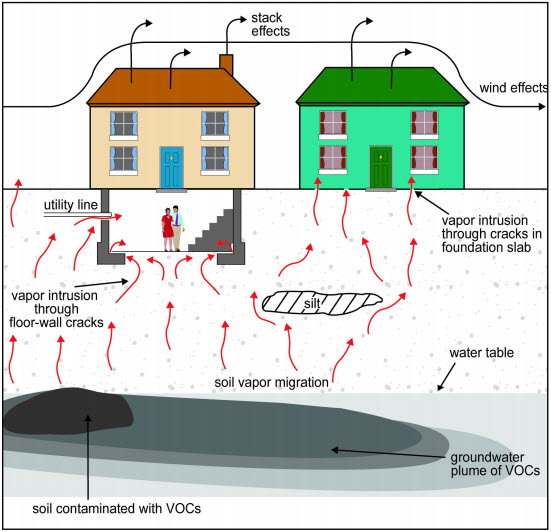What is Vapor Intrusion?
Vapor intrusion (VI) is the migration of volatile chemicals from contamination in the subsurface into overlying buildings. VI has become a major driving force for remediation of existing and newly redeveloped properties.

What is Attenuation?
Attenuation is defined as a lessening in amount of, reduction in magnitude, or weakening of a force or value. VI attenuation is the reduction in the concentration of chemicals that occurs during the migration of vapors from the subsurface, through a medium, into the indoor air (IA) of a building. Attenuation can be affected by many factors; the contaminant of concern, concentration, dilution, physical properties of a barrier (e.g., concrete slab), soil type, driving force, etc.
The attenuation factor (AF) is the ratio of the indoor air concentration to the subsurface concentration (typically soil gas or groundwater). This ratio is usually less than 1, as the indoor air contaminant concentration should be less than the subsurface concentration if the contaminant measured in the IA is solely a result of VI as the building concrete slab or other factors should be attenuating the concentrations.
Default AFs can be used to estimate indoor air concentrations as a result of a measured soil gas or groundwater concentration. The AF is an inverse measurement of the overall resistance/dilution that occurs as vapors migrate from the subsurface into a building; therefore, the AF will decrease with increasing dilution of vapors.
USEPA Recommended Attenuation Factors
The recommended attenuation factors in the United States Environmental Protection Agency (USEPA) Office of Solid Waste and Emergency Response (OSWER) Technical Guide for Assessing and Mitigating the Vapor Intrusion Pathway from Subsurface Vapor Sources to Indoor Air (EPA, 2015) are:
- 0.001 for groundwater to indoor air,
- 0.03 for sub-slab soil gas to indoor air, and
- 1.0 for crawl space air.
Be aware that AFs utilized to assess VI may differ by state and regulatory agency. These attenuation factors can be utilized to estimate the potential for VI at a site. Based on the USEPA attenuation factors, if there is a benzene sub-slab soil gas concentration of 100 micrograms per cubic meter (ug/m3), the corresponding IA concentration could be estimated at 3 ug/m3 (100 ug/m3 multiplied by the attenuation factor of 0.03). Conversely, if you have an indoor air concentration of 5 ug/m3, one could divide this number by 0.03 to calculate an estimated sub-slab soil gas concentration that may be present to generate such a concentration in indoor air, which is 167 ug/m3.
Using Henry’s Law Constant
For groundwater, when applying the AF, an adjustment is made using the dimensionless Henry’s Law constant and assuming equilibrium conditions (USEPA, 2015). The dimensionless Henry’s Law constant is the relationship between the solubility of a gas in a liquid and the partial pressure of that gas in the atmosphere above the liquid. Thus, the measure of a compound’s concentration in air relative to the concentration in water can be inferred. Therefore, if benzene is measured in groundwater at a concentration of 100 micrograms per liter (ug/L), this concentration is multiplied by the Henry’s Law constant for benzene of 2.27E-01 (unitless) and then multiplied by 1,000 to account for unit conversion, resulting in the estimated soil gas concentration of 22,700 ug/m3. The soil gas concentration is then multiplied by the attenuation factor of 0.001 to obtain the indoor air concentration of 22.7 ug/m3.
USEPA Vapor Intrusion Screening Level Calculator
The USEPA has an online tool called the Vapor Intrusion Screening Level (VISL) Calculator that can be utilized to perform these calculations. The VISL Calculator allows for adjustments to average groundwater temperature and also the evaluation of different exposure scenarios, as these factors affect the results. For example, the VISL assumes the groundwater temperature typical for Florida at 25ºC. Therefore, to further evaluate potential area-specific factors, a more appropriate temperature for sites in the northeast may be 10 to 15ºC, which may result in lower indoor air concentrations if evaluating the groundwater to IA pathway.
Benefits of Using Attenuation Factors
The AF can also be useful for determining if indoor air sources are present versus solely sub-slab sources for different chemicals. Site-specific AFs can be calculated using data collected from a site. A site-specific AF can be determined if collocated sub-slab and indoor air samples are collected during the same event (divide indoor air concentration by sub-slab concentration). If a comparison of AFs shows that chemical compounds differ by orders of magnitude, this is a good indication that the compounds with higher AFs are more likely from indoor air sources. Using this approach, AFs often come into play when evaluating the effectiveness of a sub-slab depressurization system (SSDS) that is installed at a site to mitigate VI and indoor air contaminants continue to be detected. AFs can be used as a line of evidence to demonstrate if a majority of the VI is being controlled by the SSDS or if any remaining IA concentrations over standards are from a likely indoor air source, enabling closure of a site without costly upgrades or unnecessary repairs to the SSDS.
It is important to note that regulatory agencies do not allow utilization of AFs alone to assess potential exposure from VI; however, the AF is an important line of evidence to determine if potential problems may exist before more costly evaluations are completed.
How Can VERTEX Help?
VERTEX has experience conducting all phases of VI evaluations nationally. The VERTEX team of engineering and environmental professionals has the experience and expertise to facilitate VI investigations, interpret the results, and if needed, develop and implement mitigation strategies and their associated cost estimates. Our Environmental and Engineering Experts can partner with you to resolve complex challenges.
To learn more about VERTEX’s Environmental Consulting services or to speak with an Environmental Expert, call 888.298.5162 or submit an inquiry.




